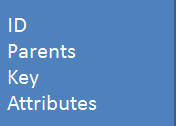
This page deals with Quick Dimension related functionality.
Note: The Quick Dimension functionality only supports online access, meaning that no data mart related access views or snapshot table functionality is supported.
A dimension is an entity that provides the possibility to categorize transactional data represented by a Fact entity. The Fact and the Dimensions defines an Information Source.
Generally a Dimension has the following attributes:

The ID is a unique identity but in most cases not defined as a technical key, e.g. as a sequence or GUID. Instead the ID is by default defined as a string where the parent attributes (Parents) and the Key attribute are combined.
The important thing here is that a Dimension should not have more than one Key attribute. In IFS Applications database it is not uncommon that a table has more than one key columns. The Business Reporting & Analysis services framework expects dimensions to contain one Key. The key attribute is normally named CODE.
In the standard implementation a parent dimension will be created for each one of the parent attributes. The overall picture looks like this:
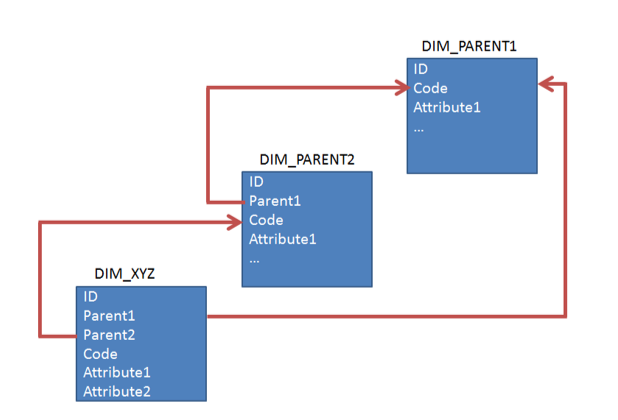
In the above case the dimension DIM_XYZ has two parent attributes (Parent1 and Parent2) and one key attribute named Code. The dimension will be defined to have two parents where Parent2 attribute is associated with the Code attribute of DIM_PARENT2. The Parent1 attribute in DIM_XYZ is associated with the Code attribute in DIM_PARENT1. As can be seen from the figure there is also a relation between dimensions DIM_PARENT2 and DIM_PARENT1.
When Quick Dimensions are automatically drafted during creation of a Quick Information Source draft, view reference information will be used to figure out how dimensions are related to each other. This process might lead to errors if it is not possible to figure out the correct relations. All errors related to dimension parents should consider this general dimension information. The goal should be define dimensions and parent dimensions as in the above figure to avoid errors.
Sometimes it is however not possible to easily create a Quick Dimensions to act as a parent, .e.g. if one of the parent keys is based on a enumeration entity. Sometimes the solution will be to create the Dimension from the Draft and then modify the metadata of the dimension in the Information Source feature.
Also consider Quick Information Source examples.
In order to create a Quick Dimension it is necessary to first create a draft. This is handled in the Quick Information Source Drafts feature in Solution Manager.

By selecting the Draft a Quick Dimension
task, the following dialog opens up. Specify if
the source should be an ordinary LU view or an IAL view.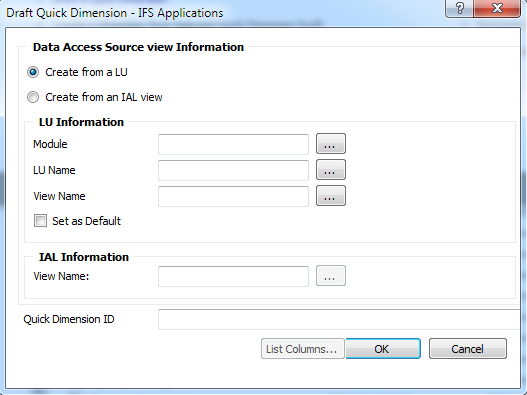
| Form Section/Attribute | Description |
|---|---|
Data Access Source View Information
|
Specify the source for the Quick Dimension Draft.
Either an ordinary LU view or an IAL view. |
| LU Information | If Create from a LU is selected the LU Information is supplied here. Module, LU Name, View Name can be selected from List of Values. |
| IAL Information | If Create from an IAL View is selected then supply the IAL view name. List Of Values is available. |
| Quick Dimension ID | ID for the Quick Dimension to be drafted.
By default the ID is suggested as QDIM_<view_name>. E.g. QDIM_CURRENCY_CODE. The field is editable. |
| List Columns | Opens a list that shows all columns in the select source views. |
When drafting a Quick Dimension, follow these steps:
Select check box Set as Default if the new Quick Dimension should be considered as the default dimension for the selected LU Name. Use the following link to get more information >>
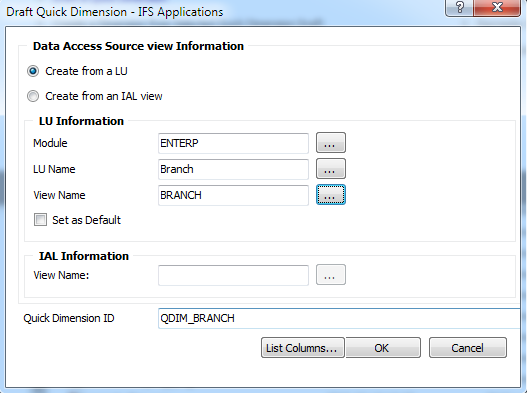
Drafted quick dimension will be displayed in the Quick Information Sources Drafts feature as follows:
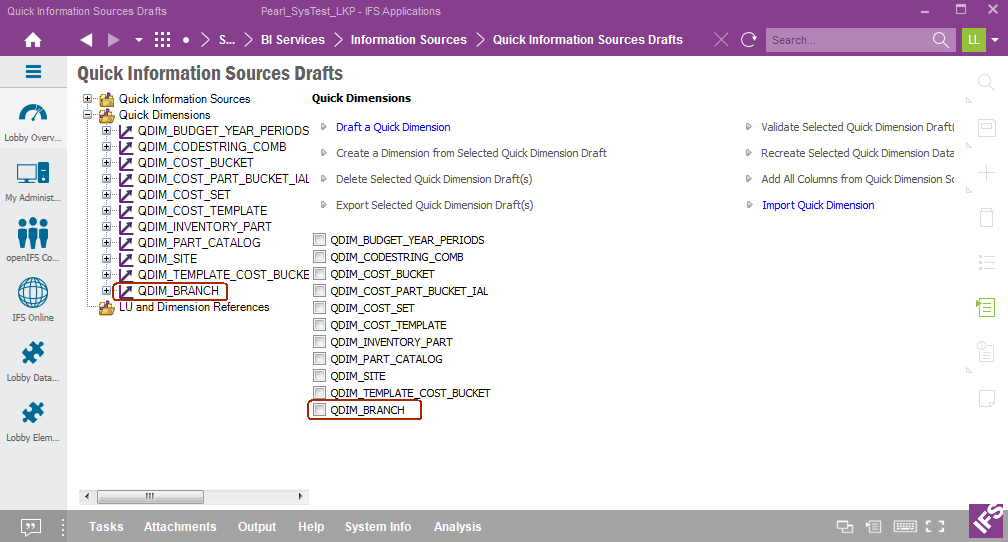
Details of the Quick Dimension will be displayed in the Quick Dimension Details form as follows.
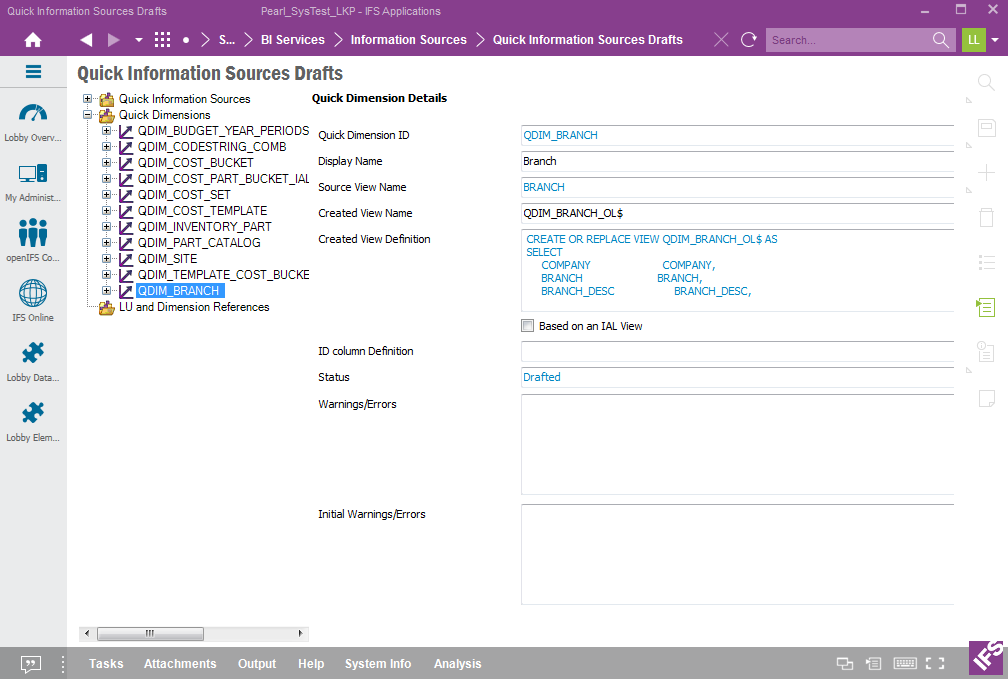
| Attribute | Description |
|---|---|
| Quick Dimension ID | Quick Dimension ID which is given when drafting an dimension in the Draft Quick Dimension dialog. |
| Display Name | Name of the dimension displayed in the BR Client Navigator |
| Source View Name | Name of the source view |
| Created View Name | View name created when drafting/creating a quick dimension. |
| Created View Definition | View definition to be used when creating final source view. |
| Based on IAL View | Will be selected if the Quick Dimension is drafted/created using an IAL view |
| ID Column Definition | Unique identifier for the dimension, created by concatenating parent and key columns of the source view. |
| Status | Status of the Quick Dimension; either Drafted or Created |
| Warnings/Errors | Warnings/Errors generating when drafting a quick dimension. These needs to be reviewed before creating the dimension from the draft. |
| Initial Warnings/Errors | Warnings/Errors generated from the source view before any processing is done. These are mostly related to the column references. Initial warnings and errors can sometimes be corrected by the processing. |
The ID column is created automatically but the format of the concatenated keys might not be correct, especially when the involved columns does not have the same data type. It is possible to modify the ID column definition. In the Quick Dimension Details window, use RMB Generate Dimension ID.

All columns involved in creating the dimension ID are presented. It is now possible for each column to select a format Function and also define a Format to be applied for the selected format function. The resulting ID Column Definition will be displayed in the dialog. When OK is pressed, the current definitions in the dialog will be used to create the final definition of the ID column.
By selecting the drafted Quick Dimension in the left hand navigator and then selecting the Items folder, all details of drafted items will be displayed in the Quick Dimension Item Details form.
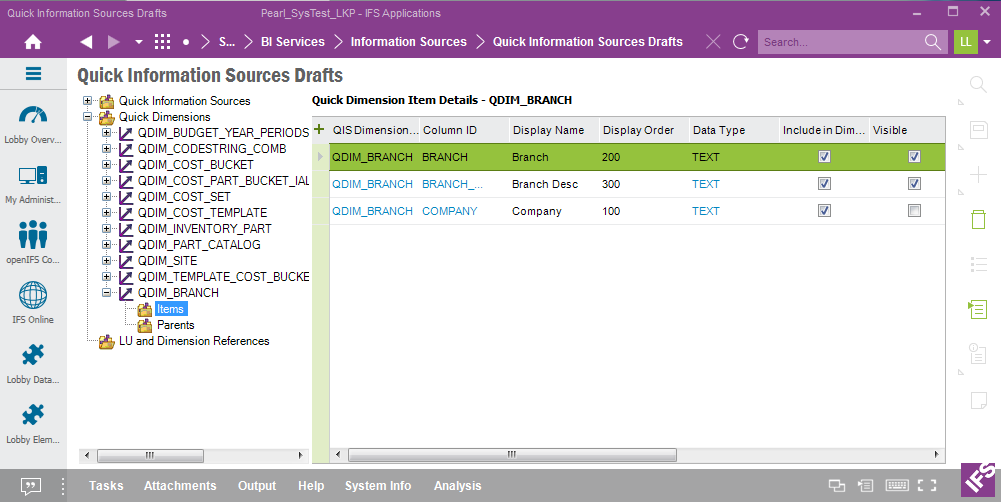
| Attributes | Description |
|---|---|
| QIS Dimension Id | The ID of the dimension. By default defined as QDIM_<view_name>. |
| Column ID | A unique identification of a column in the source view, selected to be drafted/created in the dimension. |
| Display Name | The display name of the item |
| Display Order | This is the display order of the column in the Information Source navigator in IFS Business Reporter client. The value is set even if the column is or will be marked as not visible. Use this column to modify the display order if the suggested order is not good enough. |
| Data Type | Data type for the column in the dictionary (view definition). This field can be modified. Data types can be DATE, NUMBER, VARCHAR2 |
| Include in Dimension | This check box indicates whether the item should be included in the Dimension. |
| Visible | This check box indicates the item should be visible in the IFS Business Reporter client |
| Referenced LU | Logical unit reference to which the quick or standard dimension is created/drafted. |
| ID Column | This check box indicates whether the item should be included in the concatenated ID Definition. All the parent and Key columns should be marked as ID columns. For all parent columns that are part of the ID, not the key column, a corresponding parent dimension and a parent dimension item should be defined in Parents. |
| Key Column | This check box indicates whether the item is a Key column. Key column will be used as the code item of the dimension. Only one key column should exist. |
| Warnings/Errors | Warnings/Errors generating when drafting a quick dimension. These needs to be reviewed and corrected before creating the quick dimension. |
| Initial Warnings/Errors | Warnings/Errors generated from the source view before any processing is done. These are mainly related to references. Contents of this column will not be modified. User should refer the column Warnings/Errors to find out the warnings/errors for the current state of the Quick Information Source. |
Note: It is possible to modify the ID Column definition of the dimension by applying format functions and masks. Use RMB Generate Dimension ID in Quick Dimension Details form.
This window presents all parent details for Quick Dimension Draft.
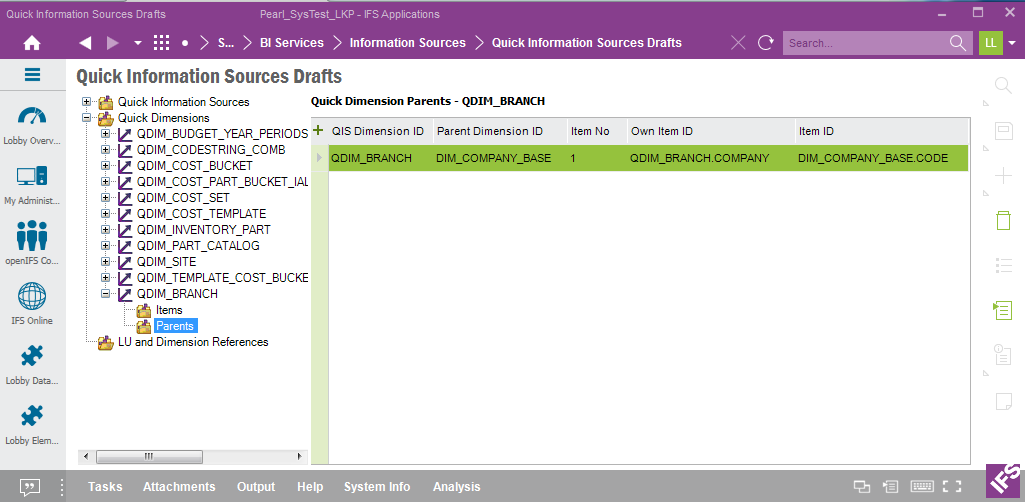
| Attributes | Description |
|---|---|
| Quick Dimension ID | The ID of the quick dimension. By default defined as QDIM_<view_name>. |
| Parent Dimension ID | The ID of the identified parent dimension. |
| Item No | Parent item no in hierarchical order. |
| Own Item ID | The item ID of the dimension for which the parent is defined. |
| Item ID | The ID of the parent dimension item. The parent Item ID is represented by the Own Item Id in the current dimension. |
All drafted quick dimensions will be listed under the Quick Dimensions folder, Quick Dimensions form.
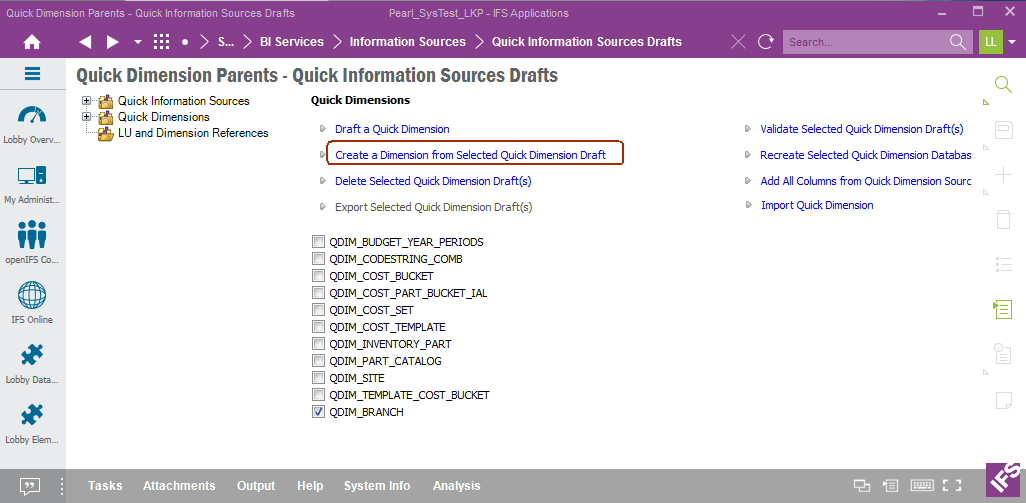
To create an quick dimension from a Draft, follow these steps:
Select Delete Selected Quick Dimension Draft(s) link to delete quick dimension drafts. One or many quick dimension drafts can be deleted using this option.
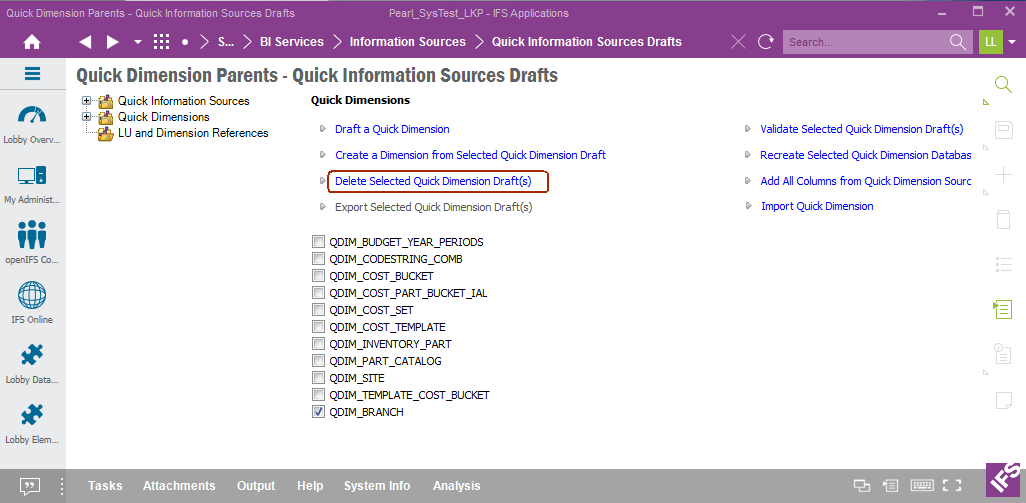
To delete quick dimension draft(s), follow these steps:
Quick Dimension draft definitions can be exported and imported.
Export comes in two flavors:
To perform export, select Quick Dimensions and click on the link Export Selected Quick Dimension Draft(s)
This option can be used to export the metadata and source view related to a Quick Dimension. The metadata file has the extension INS and the view file has the extension APV.
It is required that selected Dimensions are in Created state.
The exported metadata file and source view file can e.g. be used in the following way:

This option can be used to export the Quick Dimension definitions from one environment and then to move it to another environment by importing it via the IEE client.
The selected Dimensions can be in any state. It is only the draft definitions that will be exported.
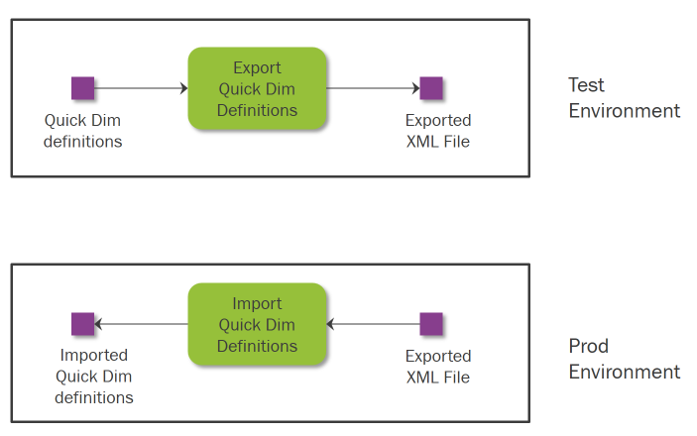

| Attributes | Description |
|---|---|
| Export To | The output folder location of the Quick Dimension related files export |
| QIS/QIS Dimensions to be Exported | The list of Quick Information Sources to be exported. Export of Quick Dimensions uses the same dialog. |
| Export Meta Data (To import from IFS EE Client) | By selecting this check box, an XML file with draft definitions will be exported for each Quick Dimension |
| Export Meta Data (To import from database) | By selecting this check box, a metadata file will be exported for each Quick Dimension. |
| Export View Definition | By selecting this check box the access view definition of each Quick Dimension will be exported. |
| Create Folder Structure | Selecting this check box leads to creating a folder structure when exporting, i.e. suitable for adding files to the code handling system. |
| Dependencies | Any dimension that is not selected but has a dependency to the Quick Dimension selected for exported, will be listed here. User can export these if required. |
The Import Quick Dimension option can be used to import previously exported Quick Dimension draft definitions.
It is only possible to import definitions exported as XML file. Exported metadata file and/or source view file can not be imported via IEE.
Import can only be performed if the end user has been granted access to the activity ImportQuickInfoSrc.
A typical scenario is:
Note: The imported definitions will be in Drafted state
Select the link Validate Selected Quick Dimension Draft(s) to validate the source view used to draft the quick dimension with the current state of the view. It validates data type and existence of columns.
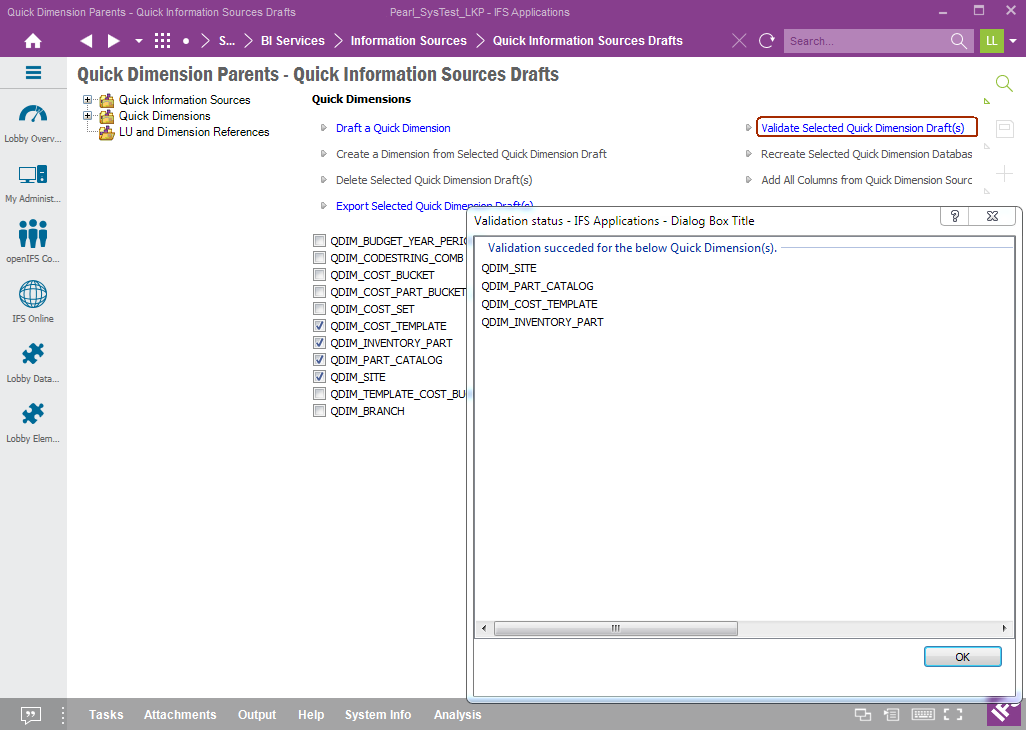
Successfully validated Quick Dimension Drafts will be listed in the above window.
Select the link Recreate Selected Quick Dimension Database View to recreate the view definition of the selected quick dimension.
The following applies:
The recreation will fail if the view associated with the Quick Dimension has been altered by other means. If e.g. the view has been overwritten by an ordinary view definition, it will not be possible to recreate the view, due to that the view must have specific properties to be considered as the source for a Quick Dimension source.
Select the link Add All Columns from Quick Dimension Source View to add all the columns which were not included when drafting a Quick Dimension.
If the source view has changed since it was originally drafted and an Dimension has been created, then it is necessary to:
Note: The draft must be in state Drafted to enable addition of new source view columns.